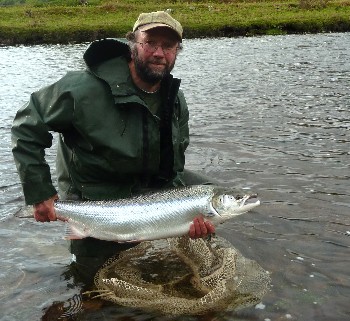2011, a record year for multi-sea winter salmon. Why?
Posted: Thursday 2 February, 2012 @ 11:15:13

The salmon fisheries of Wester Ross experienced somewhat contrasting fortunes in 2011. Overall, it was another good year. The River Ewe system recorded its highest total rod catch of salmon and grilse since 1992, of about 340 fish (final figures to follow). However, total catches of salmon and grilse from the Gruinard River, Little Gruinard River & River Carron were down on those of 2010.
To investigate further, records of individual rod caught fish for years 2010 and 2011 were provided by Graeme Wilson and Ray Dingwall (keepers for the Little Gruinard River and River Ewe respectively), and Bob Kindness of the River Carron.
The three rivers’ catches tell a similar story. In 2010, grilse catches were the highest on record for the Carron and both the Ewe and Little Gruinard also enjoyed a very good year for grilse (see Newsletter 26). However, in 2011, catches of multi-sea winter salmon for all three rivers were the highest since at least 1992; even though the combined total catches (grilse and salmon together) for the Little Gruinard and Carron were slightly less than in 2010.
From a comparison of individual fish data for these rivers, it is already clear that the 2 sea-winter salmon, the survivors of the smolt-year class that emigrated in 2009 from the river systems of Wester Ross, have been unusually successful with high rates of marine survival and return. Please click here for details.
Same old story? Well, yes! As explained in both of the last two WRFT Newsletters the late spring and early summer of 2009 were noted for a remarkable abundance of sandeels around the shores of Wester Ross. Sea trout sampled by WRFT in coastal waters and river estuaries in June and July 2009 were the fattest seen since we started recording ’condition factor’.
The catch of two sea-winter [2SW] salmon in 2011 is consistent with the hypothesis that for salmon fisheries, the first few weeks at sea for post-smolt salmon are critical. Given an abundance of prey for post-smolts (e.g. small sandeels) and on abundance of alternative prey (e.g. large sandeels) for the fish-eating birds (e.g. heron, merganser, cormorant, gannet) and fish (e.g. pollack, coalfish, cod) that are know to eat salmon smolts and post-smolts, rates of marine survival for salmon can be much higher than in years when other prey fish are scarce.
The abundance of juvenile fishes in the inshore marine environment is not simply something that varies randomly in accordance with climate changes and cycles. Sandeels, herring and sprats, use the seabed as spawning habitat. Fisheries target all three. With a list of proposed Marine Protected Areas around Scotland to be published later in 2012, will the Scottish Government be far sighted and take an ecosystem approach to the protection of inshore spawning and nursery areas of ‘keystone’ fishes: sandeels, sprats and herrings, to the benefit of wild salmon, sea trout and many other fish species and sea birds?
Detailed catch data also supports the view that different rivers continue to support different salmon populations. The Little Gruinard consistently produces a higher ratio of grilse to MSW salmon than the River Ewe. This observation seems to be consistent from year to year. Given the character of respective rivers, an obvious explanation is that it is adaptive and has a genetic basis: grilse are more successful in the Little Gruinard than bigger salmon. In the Ewe, however, there are relatively more places where big salmon can reach and spawn successfully.
For further details and analyses of salmon catches in Wester Ross in 2011, please visit the downloads page, or click here.
For further information about recent advances in our knowledge of salmon at sea, please visit the ’Salmon Summit (October 2011) website: www.nasco.int/sas/salmonsummit.htm
For information about how to estimate the sea age of your rod caught salmon, please go to the SALWRD salmon age calculator: www.mathstat.strath.ac.uk/outreach/salwrd/calculator/index.php
and the SALWRD leaflet: www.mathstat.strath.ac.uk/outreach/salwrd/repo.php?id=9